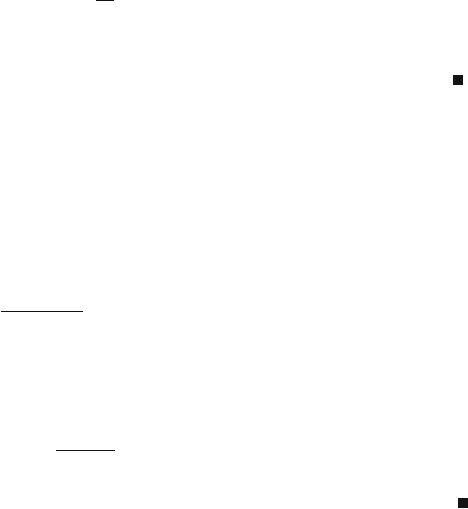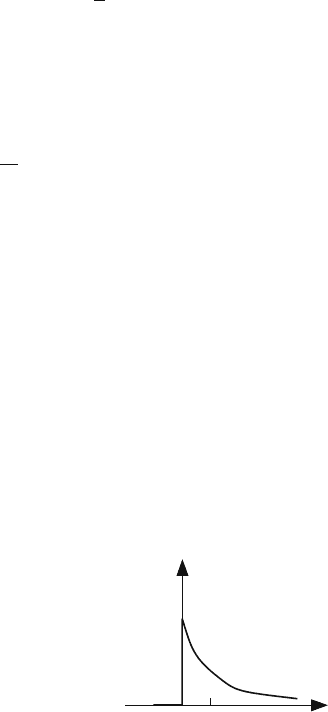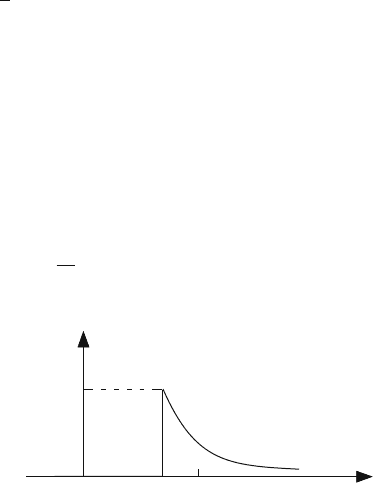Gebali F. Analysis Of Computer And Communication Networks
Подождите немного. Документ загружается.


11.3 Continuous-Time Modeling: Poisson Traffic Description 389
The cdf for the random variable T is given from (11.10) by
F
T
(t) = p(T ≤ t) = 1 −e
−
a
t
(11.11)
The pdf for this random variable is obtained by differentiating the above equation
f
T
(
t
)
=
a
e
−
a
t
(11.12)
Thus the pdf for the interarrival time of Poisson traffic follows the exponential
distribution that was discussed in Chapter 1.
Example 11.2 Find the average value for the exponentially distributed interarrival
time having the distribution in (11.12)
The average time between arriving packets T
a
is given by
T
a
=
∞
t=0
t
a
e
−
a
t
dt
=
1
a
s
We see that as the rate of packet arrival decreases (
a
1), the average time
between packets increases as expected.
Example 11.3 Consider an ATM channel where a source transmits data with an
average data rate of 500 kbps. Derive the corresponding Poisson distribution and
find the probability that 10 cells arrive in a period of 1 ms.
Since we are talking about cells, we have to convert all the data rates from bits
per second quantities into cells/second using the information we have about average
packet length A. We start by calculating the average arrival rate which is easily done
since we know the size of an ATM cell.
a
=
500 ×10
3
8 ×53
= 1.179 2 ×10
3
cells/s
The probability of 10 cells arriving in the time period t according to the Poisson
distribution is found using (11.7):
p(10) =
(
a
t)
10
(10)!
e
−
a
t
= 4.407 ×10
−7
11.3.1 Memoryless Property of Poisson Traffic
The memoryless property of Poisson traffic is defined using the following condi-
tional probability expression related to the interarrival time:

390 11 Modeling Network Traffic
p(T > t +|T > t) = p(T >) for all t,>0 (11.13)
Basically, this equation states that the probability that no packets arrive for a time
t + , given that no packets arrived up to time t, does not depend on the value of
t. It depends only on . So, in effect, the expression states that we know that we
waited for t seconds and no packets arrived. Now we reset our clock and we ask
the question: What is the probability that a packet arrives if we wait for a period
seconds? The probability of this event only depends on our choice of value and
will not use our prior knowledge of the period t.
Let us state this property using two examples of systems having the memoryless
property. Assume that we are studying the interarrival times of buses instead of
packets. Assume also that the time between bus arrivals is a random variable with
memoryless property. We arrive at the bus stop at 9:00 a.m. and wait for 1 h yet no
buses show up. Now we know that no buses showed up for the past hour, and we
naturally ask the question: What are the odds that a bus will show up if we wait for
five more minutes. The probability that no buses will come in the next five minutes
will depend only on the wait period (5 min) and not on how long we have been
waiting at the bus stop.
Another example of memoryless property is the case of an appliance (a television
set for example). If the time between failures is a random variable with memoryless
property, then the probability that the TV will fail after 1 h of use is the same at any
time independent of when we bought the TV or how long the TV has been used.
Obviously, the time between failures in cars and airplanes has a memory property.
That is why an older car breaks down more often when compared to a new car or
when compared to an older car that is only driven on weekends in the summer
months only.
Let us turn back to our interarrival time statistics. From (11.9), we could write
p(T > t) = e
−λ
a
t
(11.14)
Changing the time value from t to t +, we get
p(T > t +) = e
−λ
a
(t+)
(11.15)
Equation (11.13) is a conditional probability, and we can write it as
p(A|B) =
p
A
(
B
p(B)
(11.16)
where the events A and B are defined as
A : T > t + (11.17)
B : T > t (11.18)

11.3 Continuous-Time Modeling: Poisson Traffic Description 391
But A
(
B = A since >0 implies that if event A took place, then event B has
taken place also. Thus we have
p(T > t +|T > t) =
p(A)
p(B)
(11.19)
=
e
−λ
a
(t+)
e
−λ
a
t
(11.20)
= e
−λ
a
(11.21)
Thus we have proved that the interarrival time for the exponential distribution is
memoryless.
11.3.2 Realistic Models for Poisson Traffic
The Poisson distribution and the interarrival time considered in Section 11.3 do
not offer much freedom in describing realistic traffic sources since they contain
one parameter only: λ (packets/s) that reflected the average data arrival rate. The
minimum value for the interarrival time is zero. This implies that the time interval
between two packet headers could be zero. An interarrival time value of zero implies
two things: that our packets have zero length and that the data rate could be infinity.
Both of these conclusions are not realistic.
A realistic bursty source could be described using the parameters.
λ
a
the average data rate
σ the maximum data rate expected from the source
Since we are talking about rates in terms of packets/second, we need to make
sure that the rates are in terms of packet/second. The source parameters above could
be elaborated upon further, depending on our need. Section 11.2.1 discusses source
with multiple data rates.
Now we ask the question: How can we write down an expression for a Pois-
son distribution that takes into account all of the source parameters? We have two
options:
1. Flow description: This option allows us to specify the randomness of the instan-
taneous data rate produced by the source.
2. Interarrival time description: This option allows us to specify the randomness of
the periods between adjacent packets produced by the source.

392 11 Modeling Network Traffic
11.3.3 Flow Description
We start by writing the pdf for the instantaneous data rate in the form
f
Λ
(λ) = b e
−bλ
(11.22)
where λ is the data rate, and the parameter b is the shape parameter that determines
the steepness of the exponential curve.
Figure 11.4 shows the distribution; λ
a
in the figure indicates the average data
rate. The distribution in (11.22) is a valid pdf since its integral equals unity.
To find the parameter b, we need to estimate the average data rate λ
a
. The average
data rate for the distribution given in (11.22) is
λ
a
=
∞
0
λ b e
−b λ
dλ =
1
b
(11.23)
Based on this equation, we can determine the pdf for the data rate produced by
the source, given its average rate. If λ
a
is the average data rate of a source, then the
pdf for its rate is given by
f
⌳
(λ) =
1
λ
a
e
−λ/λ
a
(11.24)
Thus to describe the data rate of a source that follows the Poisson distribution,
we need to specify its average data rate λ
a
only.
11.3.4 Interarrival Time Description
The pdf description of the interarrival time for a Poisson source follows the expo-
nential distribution which we repeat here for convenience.
f
T
(
t
)
= λ
a
e
−λ
a
t
(11.25)
We mentioned that this equation is not sufficient to describe real traffic since it
contains only one parameter, λ
a
, which describes only the average data rate. We can
Fig. 11.4 Exponential
distribution describing
instantaneous rate of a
Poisson source
λ
f
Λ
(λ )
λ
a
b

11.3 Continuous-Time Modeling: Poisson Traffic Description 393
modify the interarrival time distribution and obtain the biased exponential distribu-
tion as follows.
f
T
(t) =
0 t < a
b exp −b
(
t −a
)
t ≥ a
(11.26)
where a ≥ 0istheposition parameter (units s) and b > 0istheshape parameter
(units s
−1
). Basically, a represents the minimum time between adjacent packets, and
b determines how fast the exponential function decays with time. Both a and b will
determine the average packet rate as will be explained in Example 11.4.
Figure 11.5 shows the distribution given by the expression in (11.26). The figure
details that a places the pdf at the desired position on the time axis and b determines
how fast the exponential function decays with time. The distribution in (11.26) is a
valid pdf since its integral equals unity. The next section explains how to obtain the
correct values for a and b for a typical source.
Example 11.4 Find the average value for the exponentially distributed interarrival
time with pdf given by (11.26)
The average time separation between arriving packets T
a
is given by
T
a
=
∞
t=a
tbexp(−b(t − a)) dt
= a +
1
b
s
The average interarrival time T
a
depends on both a and b parameters. We see
that as the shape parameter decreases (b 1), the average time between packets
increases.
On the other hand, when b is large (b 1), the exponential function will ap-
proach a delta function, and the interarrival time will have its minimum value T
a
≈ a.
The variance of the interarrival time for the shifted exponential distribution is
given by
σ
2
=
1
b
2
Fig. 11.5 A biased
exponential distribution with
two design parameters:
position parameter a and
shape parameter b
Interarrival time
f
T
(t)
b
a T
a

394 11 Modeling Network Traffic
which depends only on the shape parameter. So large values for b will result in
traffic with low burstiness approaching CBR (constant bit rate). Lower values for b
result in more bursty traffic.
11.3.5 Extracting Poisson Traffic Parameters
In this section, we show how to find the values of the position parameter a and shape
parameter b for a source whose average rate λ
a
and burst rate σ are known.
The position parameter a is equivalent to the minimum time between two ad-
jacent packets. In a time period t,themaximum number of packets that could be
produced by the source is given by
N
m
= σ t (11.27)
where it was assumed that σ was given in units of packets/second. The minimum
time between two adjacent packets was defined as a and is given by
α =
t
N
m
=
1
σ
s (11.28)
Problem 11.5 discusses about obtaining the parameter a when σ is expressed in
units of bits/second.
In a time period t,theaverage number of packets that could be produced by the
source is given by
N
a
= λ
a
t (11.29)
The average time between two adjacent packets is given by
T
a
=
t
N
a
=
1
λ
a
s (11.30)
But from Example 11.4, we obtained an expression for the average interarrival
time as
T
a
= a +
1
b
s (11.31)
From the above two equations, we are able to obtain a value for the shape param-
eter b
1
λ
a
= a +
1
b
(11.32)

11.3 Continuous-Time Modeling: Poisson Traffic Description 395
Therefore, we have
b =
σλ
a
σ − λ
a
s
−1
(11.33)
Problem 11.6 discusses obtaining the parameter a when σ and λ
a
are expressed
in units of bits/second.
Example 11.5 A data source follows the Poisson distribution and has an average
data rate λ
a
= 10
3
packets/s and maximum burst rate of σ = 3 × 10
3
packets/s.
Estimate the exponential distribution parameters that best describe that source.
The position parameter is given from (11.28) by
a =
1
3 ×10
6
= 3.33 ×10
−4
s
The shape parameter b is given from (11.33) by
b = 1500 s
−1
The pdf for the interarrival time is given by
f
T
(t) = 1500 exp −1000
t −3.3 ×10
−4
11.3.6 Poisson Traffic and Queuing Analysis
The previous subsection discussed how the biased exponential distribution parame-
ters can be extracted given the system parameters:
λ
a
the average data rate
σ the maximum data rate expected from the source
A Poisson source matching these given parameters has position parameter given
by (11.28) and shape parameter given by (11.33). In this section, we ask the ques-
tion: Given a Poisson source with known parameters that feed into a queue, what is
the packet arrival probability for the queue? Remember that in queuing theory, the
two most important descriptors are the arrival statistics and the departure statistics.
There are two cases that must be studied separately based on the values of the
step size T and the position parameter a.

396 11 Modeling Network Traffic
Case When T ≤ a
The case T ≤ a implies that we are sampling our queue at a very high rate that is
greater than the burst rate of the source. Therefore, when T ≤ a at most, one packet
could arrive in one time step with a probability x that we have to determine. We use
the symbol x for arrival probability since the symbol α is used here to describe the
position parameter.
The number of time steps over a time period t is estimated as
n =
t
T
(11.34)
The average number of packets arriving over a period t is given by
N
a
= λ
a
t
= λ
a
nT (11.35)
where λ
a
was assumed to be given in units of packets/second.
From the binomial distribution, the average number of packets in one step time is
N
a
= xn (11.36)
where x is the packet arrival probability in one time step.
From the above two equations, the packet arrival probability per time step is
given by
x = λ
a
T (11.37)
We see in the above equation that as T gets smaller or as the source activity is
reduced (small λ
a
), the arrival probability is decreased, which makes sense.
Example 11.6 Estimate the packet arrival probability for a source with the follow-
ing parameters. λ
a
= 50 packets/s and σ = 150 packets/s. Assume that the time
step value is T = 1ms.
The position parameter is
α =
1
σ
= 6.7ms
The shape parameter is
β =
λ
a
σ
σ − λ
a
= 75 s
−1

11.3 Continuous-Time Modeling: Poisson Traffic Description 397
The packet arrival probability is
x = 0.05
Case When T > a
The case T > a implies that we are sampling our queue at a rate that is slower than
the burst rate of the source. Therefore, when T > a, more than one packet could
arrive in one time step and we have to find the packet arrival statistics that describe
this situation.
We start our estimation of the arrival probability x by determining the maximum
number of packets that could arrive in one step time
N
m
=σ T (11.38)
The ceiling function was used here, after assuming that the receiver considers
packets that partly arrive during one time step. If the receiver does not wait for
partially arrived packets, then the floor function should be used.
The average number of packets arriving in the time period T is
N
a
= λ
a
T (11.39)
From the binomial distribution, the average number of packets in one step time is
N
a
= xN
m
(11.40)
From the above two equations, the packet arrival probability per time step is
x =
λ
a
T
N
m
≤
λ
a
σ
(11.41)
The probability that k packets arrive at one time step T is given by the binomial
distribution
p(k) =
N
m
k
x
k
(1 − x)
N
m
−k
(11.42)
Example 11.7 A data source follows the Poisson distribution and has an average
data rate of λ
a
= 10
3
packets/s and maximum burst rate of σ = 5 × 10
3
packets/s.
Find the biased Poisson parameters that describe this source and find the packet
arrival probabilities if the time step is chosen equal to T = 1ms.

398 11 Modeling Network Traffic
The biased Poisson parameters are
a = 2 ×10
−4
ms
b = 1.250 ×10
3
s
−1
The maximum number of packets that could arrive in one time step is
N
m
= 5
The packet arrival probability per time step is
x = 0.2
The probability that k packets arrive per time step is
p(0) = 3.2768 ×10
−4
p(1) = 4.0960 ×10
−1
p(2) = 2.0480 ×10
−1
p(3) = 5.1200 ×10
−2
p(4) = 6.4000 ×10
−3
p(5) = 3.2000 ×10
−4
11.4 Discrete-Time Modeling: Interarrival Time for Bernoulli
Traffic
Poisson traffic description applies when time is treated as continuous. Bernoulli
traffic is analogous to Poisson traffic when time is discrete. Discrete-time traffic is
typically described by Bernoulli trials that give rise to a binomial process in which
the probability that a packet arrives at a given time step is x and the probability that
a packet does not arrive is y = 1 − x. We use the symbol x for arrival probability
since the symbol a is used here to describe the position parameter.
We can think of Bernoulli traffic with binomial packet arrival distribution as the
discrete version of Poisson traffic with exponential packet interarrival time distribu-
tion. The latter distribution could be termed a fluid flow traffic model since it deals
with flow rate as opposed to counting the number of packets that arrive in a certain
time period.
